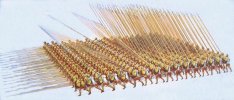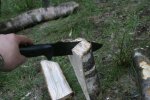Thanks for the info, kronckew. Fascinating stuf for sure. Do you know anything about the Spartan way of using the sword in the phalanx formation? The reason I ask is that kukuri better resembles the skopis sword, as opposed to gladius. So if we knew more technicalities relating to that, we could be onto something... I know, I know, the roman legion is considered far superior to Greek phalanx, but it's still relevant.
Thanks in advance,
iliam
the greek phalanx depended on the spear as the primary weapon. the greek Xiphos double edged leaf bladed short sword was very much a backup only used if the spear broke (or was cut through). the kopis was also favoured as it's bent shape could get around the enemies shield better, or make a better chop than the xiphos. the greeks were trained to fight other greeks, also in phalanx, and battles were usually a pushing contest. the heavy bronze covered shields with their arm band and hand grip were set up for pushing rather than a more mobile defence. opposing phalanx pushed until one side wore out and started getting pushed back. then the killing began. most of the deaths occurred after the losing side broke formation and started to run.
romans coming up against the phalanx were initially defeated if the greek generals properly anchored and protected their flanks and rear (like the spartans did at thermopylea). the main trouble was the greeks were inflexible, and used the same formation even if their flanks were open and their rear unprotected. the romans started winning by being more flexible and refusing to attack head on, and by going around and attacking from the sides and rear, the greeks couldn't maneuver their spears fast enough to change fronts. republican roman formations of the time also used the spear (hasta) as a primary weapon, and a tall center handgrip shield more suited to individual defence. both sides used light javelins thrown by skirmishers to open the battle. romans eventually dropped using the hasta, went to a shorter (and lighter) rectangular shield, and relied more on softening up with heavy javelins (the pilum) and then using the sword. roman armies did continue to use the hasta for special purposes and formations and for cavalry.
well after rome subdued greece, they came up against the dacians, trajan's column in rome still portrays the roman conquest of dacia in northern greece (modern bulgaria, romania, serbia). (note: pronounced with the 'c' as 'ch'. ie. datch-ee-ah) whose main weapon of choice was the two handed falx, with it's recurved blade sharp on the inside of the curve. it could cleave roman shields from the top down to the handgrip in one blow, or cut through a roman helmet to cleave the skull beneath. most roman casualties were from this. the romans added a heavy X shaped crossbar to the tops of their helmets to strengthen them thereafter. and improved the edging on the shields. dacia survives today as the brand name for an inexpensive automobile made in romania.
after the third century a.d. or so, the traditional roman legion, marius' mules, started to be unaffordable, auxilliarys who were no roman were used more often, sheild went to flat ovals, then round, swords got longer. and the phalanx-like shield wall became the formation of choice, until william broke the saxon shield wall with cavalry at hastings in 1066. after that, the infantry in medieval europe were the lowest dregs of the army rather than the highest, the cavalry - the knights. cavalry reigned supreme thru the crusades, mongol hordes, turkish invasions, etc.
that flip-flopped back again after crecy and agincourt, where the longbowmen broke the french elite. gunpowder then also was introduced, and oddly, the phalanx (swiss pikemen or scottish shiltroons) came back into favour and won battles until the musket put paid to the edged weapon.
however, never forget gibb's rule no. 9.




